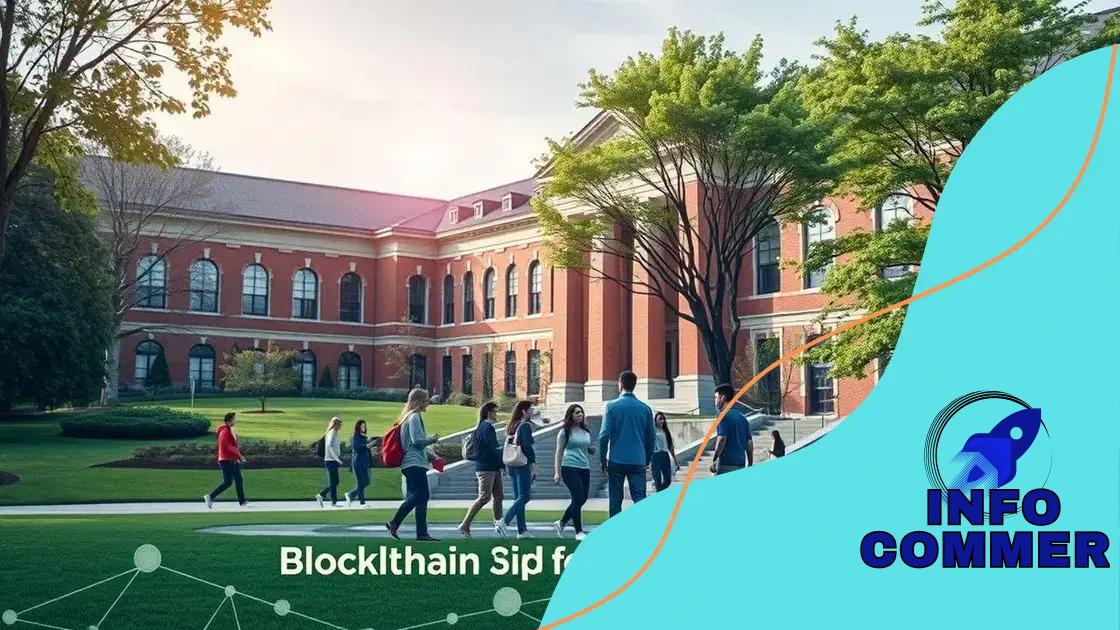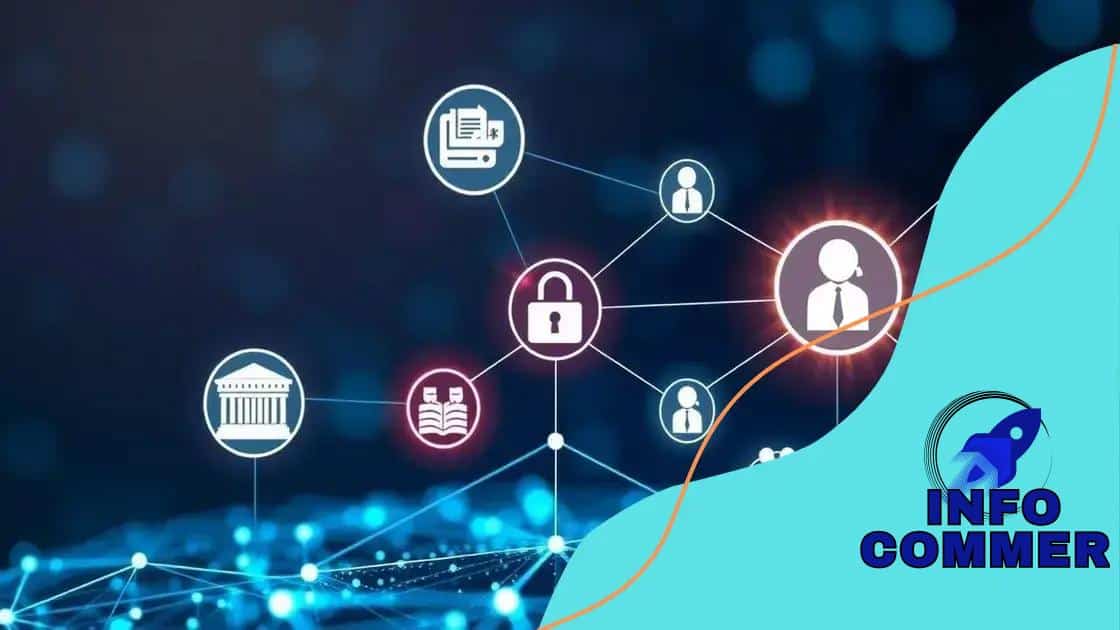Blockchain for securing academic credentials and transcripts

Blockchain is a decentralized technology that enhances the security and verification of academic credentials, providing instant access, reducing fraud, and increasing trust between educational institutions and employers.
Blockchain for securing academic credentials is transforming the way institutions verify and maintain educational records. Imagine eliminating fraudulent degrees with a secure, decentralized system. Let’s dive into how this technology reshapes academia.
Understanding blockchain technology
Understanding blockchain technology is essential for grasping how it impacts various sectors, especially education. At its core, blockchain is a decentralized digital ledger that records transactions across many computers. This ensures that the record cannot be altered retroactively without the consensus of the network.
One significant advantage of blockchain is its transparency. Every participant can access the same information, which fosters trust. Educational institutions can utilize this feature to secure academic credentials effectively.
Key Features of Blockchain
Several key features contribute to the effectiveness of blockchain technology:
- Decentralization: This means there is no single point of failure. Data is stored across a network of computers.
- Security: Transactions are encrypted, making it very difficult for hackers to alter information.
- Transparency: All transactions can be viewed by participants, enhancing trust among users.
- Immutability: Once a transaction is recorded, it cannot be changed, which is crucial for maintaining the integrity of academic records.
This transparency and security allow institutions to verify credentials quickly and easily. Imagine a student applying for a job and the employer can instantly verify their degree through the blockchain. This could eliminate fraudulent claims and instill confidence in the hiring process.
Moreover, blockchain can improve efficiency. Manual verification processes are often slow and prone to errors. By switching to a blockchain system, institutions can streamline operations significantly.
Overall, understanding the fundamentals of blockchain technology opens the door to realizing its transformative potential in securing academic credentials.
Benefits of blockchain for academic records
Exploring the benefits of blockchain for academic records reveals how this technology can change the educational landscape. By using blockchain, institutions can create a more secure and efficient process for managing credentials.
One main benefit is the enhanced security that blockchain provides. With its encryption features, academic records are less susceptible to fraud. This is crucial as fake diplomas and degrees are prevalent in today’s job market.
Key Advantages of Blockchain in Education
Blockchain technology offers several advantages:
- Increased Transparency: All transactions are visible to authorized parties, which builds trust.
- Time Efficiency: Automated verification speeds up the process of validating credentials for employers.
- Cost Reduction: Automated systems decrease the costs associated with verifying degrees.
- Decentralization: No single entity controls the data, minimizing the risks of data manipulation.
These benefits lead to a more streamlined process. For example, when students need to submit their records for job applications, employers can verify accomplishments almost instantly. This capability not only saves time but also reduces the workload for educational institutions.
Furthermore, the use of blockchain can facilitate easier access to records for students. They can maintain control over their credentials, choosing when and how to share their information. This self-sovereign model empowers learners and adds value to their educational journey.
In summary, the benefits of blockchain for academic records are significant. By increasing security, transparency, and efficiency, this technology reshapes how institutions manage and verify credentials.
How blockchain enhances credential verification

Understanding how blockchain enhances credential verification is vital for any educational institution. This technology offers a modern solution to the age-old problem of verifying academic records and qualifications.
Traditional methods of credential verification often involve lengthy processes. Employers or institutions would need to contact previous schools directly, leading to delays and potential errors. However, with blockchain, the process becomes almost instantaneous and much more reliable.
Key Advantages of Blockchain in Credential Verification
The main benefits of using blockchain for this purpose include:
- Instant Verification: Employers can verify a candidate’s academic credentials in real-time, improving the hiring process.
- Reduced Fraud: With blockchain’s immutable nature, it is nearly impossible to alter or counterfeit certificates.
- Accessibility: Stakeholders can access credentials from anywhere, making the verification process more convenient.
- Efficiency: By automating the verification process, institutions save time and resources.
Moreover, blockchain allows students to control their own credentials. They can share their records securely, choosing who gets access to their achievements. This self-management encourages accountability and empowers learners to take ownership of their academic history.
As institutions adopt this technology, we can expect an increase in trust between graduates and employers. Since all records are stored securely and can be accessed easily, the credibility of academic achievements is significantly enhanced.
In summary, leveraging blockchain enhances credential verification by making it faster, safer, and more reliable. This innovation not only benefits institutions but also greatly improves the experience for students and employers alike.
Challenges of implementing blockchain in education
Implementing blockchain in education presents several challenges that institutions must navigate to fully realize its benefits. While the technology has great potential, there are barriers that can slow down its adoption.
One major challenge is the lack of understanding and awareness of blockchain technology among educators and administrators. Many may not have the technical knowledge required to implement these systems effectively. This gap creates hesitation in adopting new technologies that could improve their processes.
Key Challenges in Implementation
Some of the core challenges include:
- Cost: Developing and maintaining a blockchain system can be expensive. Institutions must weigh these costs against potential benefits.
- Integration with Existing Systems: Integrating blockchain with current administrative systems can be complex and resource-intensive.
- Data Privacy Concerns: There may be concerns about how sensitive student information is stored and accessed on a public ledger.
- Lack of Standards: As blockchain technology is still evolving, there are few established standards for educational institutions to follow.
Additionally, regulatory issues can pose a barrier. Institutions must comply with laws related to data protection and privacy, which might complicate the implementation of blockchain. Establishing frameworks that align with these regulations is crucial.
Furthermore, resistance to change is common in any industry. Faculty and staff might be hesitant to shift from traditional processes to a new technology. Training and support are necessary to ease this transition and foster acceptance.
These challenges show that while blockchain in education is promising, careful consideration and strategic planning are needed to overcome these obstacles.
Future of blockchain in securing academic credentials
The future of blockchain in securing academic credentials looks promising as more educational institutions begin to recognize its potential. This innovative technology is set to revolutionize how schools and universities manage and verify academic records.
As the demand for transparency and security rises, institutions are increasingly considering blockchain as a viable solution. By adopting this technology, educational organizations can enhance the trustworthiness of diplomas and certificates, which is essential for students in a competitive job market.
Potential Developments
Several important developments could shape the future of blockchain in education:
- Wider Adoption: More schools and universities will likely integrate blockchain systems into their administrative processes, leading to a standardization of credential verification.
- Interoperability: Future systems may allow for better collaboration among institutions, enabling seamless sharing of records across different educational bodies.
- Improved User Control: Students may gain greater control over their educational records, allowing them to grant access to potential employers or educational institutions securely.
- Enhanced Features: Innovations in blockchain technology could lead to features like smart contracts, which automate certain processes related to credential issuance and verification.
Additionally, partnerships between educational institutions, technology companies, and government agencies can propel the development and adoption of blockchain solutions. Such collaborations can help create the necessary infrastructure to support widespread implementation.
As blockchain technology matures, its application in education will likely expand, fostering a more efficient and reliable system for managing academic credentials. This shift will not only benefit educational institutions but also provide students with more secure and verifiable achievements.
FAQ – Questions about Blockchain in Securing Academic Credentials
What is blockchain technology?
Blockchain is a decentralized digital ledger that records transactions securely and transparently across a network.
How does blockchain enhance security in academic records?
Blockchain provides an immutable record of credentials, making it nearly impossible to alter or counterfeit academic achievements.
What are the benefits of using blockchain for credential verification?
It offers instant verification, reduces the risk of fraud, and increases transparency, making the process more efficient.
What challenges does blockchain face in education?
Challenges include high implementation costs, lack of understanding among educators, and concerns about data privacy.





